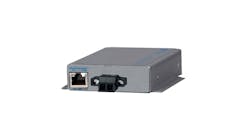The Industrial Internet of Things (IIoT) is no longer optional. System integrator Huffman Engineering Inc. reports it’s now the norm or standard on every application design for every process system, which allows for a more real-world, real-time design process.
“Simulation lets you design and see the results in earlier stages than previously. The evolution and availability of having a digital twin makes it easier to optimize processes and be more efficient in design and test out various process scenarios,” says Keith Mandachit, PE, engineering manager at Huffman, a certified member of the Control System Integrators Association in Lincoln, Neb. “Using IIoT allows data to be more actionable, making it more efficient and effective. It’s always been easy to get data, but now we’re spending more time with the end in mind. Determining what we want out of that data and how to get the data to help us make better business decisions is the key.”
Enabling cloud and virtual
Similarly, Mandachit adds that IIoT’s impact on cloud computing is more about scaling systems using subscription levels. “This enables plants to lower their initial investment by spreading costs over the lifetime of the software, and helps with the labor shortage by allowing for easier remote monitoring and control of processes and systems,” he explains. “In terms of virtualization, IIoT continues to become more and more of every process system. It reduces the need for physical servers, and in the end, reduces energy consumption because of the fewer physical computers.”
Mandachit adds that IIoT also allows virtualization to scale processes in more cost-effective ways. “The benefit of adding more servers and other equipment is that you can easily move things around to simulate situations. It gives engineers and designers the flexibility to try things out without the cost of adding physical hardware or building a system,” says Mandachit. “Fewer physical servers with cloud computing means consolidating space, saving energy, and ultimately, it’s more environmentally friendly, too. IIoT makes data more actionable and easier to access and act on.”
Find the right mix
To apply the right combination of IIoT and digitalization for applications and organizations, Mandachit reports that users must determine where they’re at in their individual automation lifecycles.
“If I had a process that had been in place for 15-20 years, it’s hard to get away from the ‘if it’s not broke, don’t fix it’ mentality, but evaluating a process using technologies, such as digital twin and digitalization that are readily available, allows users to utilize efficiencies that are effective today,” explains Mandachit. “The question is: where are you at in your automation journey? Are you at the beginning stages, where you’re identifying the business need, or are you at the point where you’re evaluating what solution is the best fit?
“For example, serialization has become important to protect against counterfeiting; so maybe you have a packaging line, where you need to implement serialization. You could use a digital twin to design the serialization solution and simulate it in your line without first physically building to see how it might impact the design.”
To decide how much computing and support resources they need, Mandachit adds that users must ask themselves many of the same questions about the status of their operations, what kinds of data processing they need, and where they should be located. Fortunately, IIoT can help with all these issues.
“You used to have to jump through a myriad of hoops to get it to the cloud. Now you can streamline that process and take it straight from the sensor to the cloud, making it provide more real-time data,” says Mandachit. “This is largely a question of resources. What the cloud affords for people is a shared resource for those who can’t maintain the traditional IT infrastructure needed to sustain their business needs—and it’s a viable option for some.
“You may be taking advantage of resources in the cloud you don’t have physically, so the question becomes all about the data processing. Do you want to make the investment in computing resources on-premise and in-house, or take advantage of resources available in the cloud? As with any database, whether it’s in-house or in the cloud, you want it to be as clean as possible, and avoid ‘garbage in garbage out’ (GIGO). This is a good opportunity to evaluate what quality your data is in. Do you have good naming conventions, making it easy to understand what data points you’re looking at, or are they obscure and unidentifiable? This will provide a good exercise in evaluating what your data looks like. In the long run, it will be worth the time to clean it up.
What's in the (digitalization) cards
In the future, Mandachit speculates that IIoT is going to be similar to what’s available today, but it’s likely to be even faster.
“With workforce shortage issues, companies will be looking to automate more processes and make decisions faster,” says Mandachit. “Automation and data aggregation make important decisions and actions easier to execute. Not only is data more readily available in a meaningful, more understandable way that makes it more actionable, but it’s also smarter. By that I mean, ultimately, it could be like ChatGPT. We could just ask the system, ‘What adjustments do I need to make to my production line to increase efficiency by 10%?’ or ‘How many employees do I need on the line during this shift for peak efficiency?’ Any automation questions we’re asking today in customer meetings could be cataloged and then aggregated with AI doing the legwork for us. This would allow engineers to more quickly diagnose the problem, and get right to the heart of engineered designs.”





